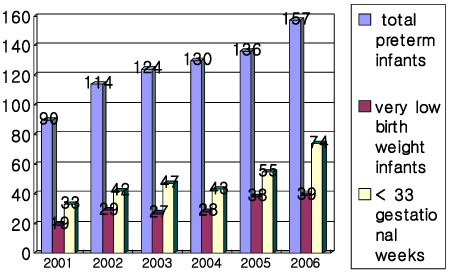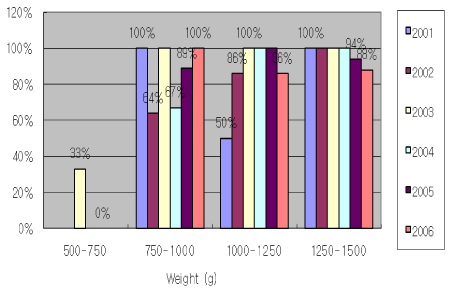Korean J Obstet Gynecol.
2010 Jan;53(1):29-34. 10.5468/kjog.2010.53.1.29.
Risk factors of preterm delivery and survival rate of preterm infants in Bucheon
- Affiliations
-
- 1Department of Obstetrics and Gynecology, College of Medicine, Soonchunhyang University, Bucheon, Korea. hhl22@chol.com, hhl22@schbc.ac.kr
- 2Department of Pediatrics, College of Medicine, Soonchunhyang University, Bucheon, Korea.
- 3Department of Preventive Medicine, College of Medicine, Chung-Ang University, Seoul, Korea.
- KMID: 2077957
- DOI: http://doi.org/10.5468/kjog.2010.53.1.29
Abstract
OBJECTIVE
The aim was to compare risk factors of preterm delivery and survival rate in preterm infants.
METHODS
There were 723 preterm deliveries among 3,299 deliveries in our hospital from February, 2001 to December, 2006. We analyzed risk factors through women who give birth to preterm infants. The risk factors of preterm delivery were evaluated survival rate, very low-birth weight (VLBW) infant ratio, preterm infants to 751 preterm infants who was admitted at newborn intensive care unit. The data were retrospectively reviewed of hospital record and statistical analysis was performed using chi-square test and logistic regression test.
RESULTS
The incidence rate of preterm birth increased. The risk factors that preterm premature rupture of membranes (PROM) (P<0.001), pregnancy induced hypertension (PIH) (P<0.001), twin pregnancy (P<0.001), placenta previa (P=0.009) and placenta abruption (P=0.041) as women that give birth to preterm infants were statistically significant. But, anemia (P=0.170), previous cesarean section history (P=0.780), uterine myoma (P=0.848), previous appendectomy history (P=0.999) did not statistically significant. Survival rate of total preterm infants was average 95%. And survival rate of VLBW infants was 86%.
CONCLUSION
It was found to be risk factors for preterm delivery with PROM, PIH, and placenta previa. The VLBW infants with less than 33 gestational weeks are increased every year but total survival rate is not different. We hope that we propose to research the cause of preterm delivery and survival rate of preterm infants prospectively.
Keyword
MeSH Terms
-
Anemia
Appendectomy
Cesarean Section
Female
Hospital Records
Humans
Hypertension, Pregnancy-Induced
Incidence
Infant
Infant, Newborn
Infant, Premature
Infant, Very Low Birth Weight
Intensive Care Units
Logistic Models
Membranes
Myoma
Parturition
Placenta
Placenta Previa
Pregnancy
Pregnancy, Twin
Premature Birth
Retrospective Studies
Risk Factors
Rupture
Survival Rate
Figure
Cited by 1 articles
-
Smoking Exposure and Placental Vascular Compromise: A Nationwide Population-Based Study in South Korea
Haeyong Pak, Ji Sun Yoon, Hae Won Baek, Jae Eun Chung
J Korean Soc Matern Child Health. 2019;23(3):155-161. doi: 10.21896/jksmch.2019.23.3.155.
Reference
-
1. Zeka A, Melly SJ, Schwartz J. The effects of socioeconomic status and indices of physical environment on reduced birth weight and preterm births in Eastern Massachusetts. Environ Health. 2008. 7:60.3. Xiong X, Zhang J, Fraser WD. Quitting smoking during early versus late pregnancy: the risk of preeclampsia and adverse birth outcomes. J Obstet Gynaecol Can. 2009. 31:702–707.4. Kalia JL, Visintainer P, Brumberg HL, Pici M, Kase J. Comparison of enrollment in interventional therapies between late-preterm and very preterm infants at 12 months' corrected age. Pediatrics. 2009. 123:804–809.5. Shapiro-Mendoza CK, Tomashek KM, Kotelchuck M, Barfield W, Weiss J, Evans S. Risk factors for neonatal morbidity and mortality among "healthy," late preterm newborns. Semin Perinatol. 2006. 30:54–60.6. Shapiro-Mendoza CK, Tomashek KM, Kotelchuck M, Barfield W, Nannini A, Weiss J, et al. Effect of late-preterm birth and maternal medical conditions on newborn morbidity risk. Pediatrics. 2008. 121:e223–e232.7. Tomashek KM, Shapiro-Mendoza CK, Weiss J, Kotelchuck M, Barfield W, Evans S, et al. Early discharge among late preterm and term newborns and risk of neonatal morbidity. Semin Perinatol. 2006. 30:61–68.9. Creasy RK, Resnik R, Iams JD, editors. Creasy & Resnik's Maternal - Fetal medicine: principles and practice. 2008. 6th ed. Edinburgh: Saunders.10. Shapiro-Mendoza CK, Kimball M, Tomashek KM, Anderson RN, Blanding S. US infant mortality trends attributable to accidental suffocation and strangulation in bed from 1984 through 2004: are rates increasing? Pediatrics. 2009. 123:533–539.12. Joseph KS. Theory of obstetrics: an epidemiologic framework for justifying medically indicated early delivery. BMC Pregnancy Childbirth. 2007. 7:4.13. Longnecker MP, Klebanoff MA, Zhou H, Brock JW. Association between maternal serum concentration of the DDT metabolite DDE and preterm and small-for-gestational-age babies at birth. Lancet. 2001. 358:110–114.14. Wood SL, Jarrell JJ, Swaby C, Chan S. Endocrine disruptors and spontaneous premature labor: a case control study. Environ Health. 2007. 6:35.15. Berghella V, Owen J, MacPherson C, Yost N, Swain M, Dildy GA 3rd, et al. Natural history of cervical funneling in women at high risk for spontaneous preterm birth. Obstet Gynecol. 2007. 109:863–869.16. Rahkonen L, Unkila-Kallio L, Nuutila M, Sainio S, Saisto T, Rutanen EM, et al. Cervical length measurement and cervical phosphorylated insulin-like growth factor binding protein-1 testing in prediction of preterm birth in patients reporting uterine contractions. Acta Obstet Gynecol Scand. 2009. 88:901–908.17. Iams JD, Goldenberg RL, Mercer BM, Moawad A, Thom E, Meis PJ, et al. The Preterm Prediction Study: recurrence risk of spontaneous preterm birth. National Institute of Child Health and Human Development Maternal-Fetal Medicine Units Network. Am J Obstet Gynecol. 1998. 178:1035–1040.18. Mamelle N, Laumon B, Lazar P. Prematurity and occupational activity during pregnancy. Am J Epidemiol. 1984. 119:309–322.19. Mercer BM, Goldenberg RL, Moawad AH, Meis PJ, Iams JD, Das AF, et al. The preterm prediction study: effect of gestational age and cause of preterm birth on subsequent obstetric outcome. National Institute of Child Health and Human Development Maternal-Fetal Medicine Units Network. Am J Obstet Gynecol. 1999. 181(5 Pt 1):1216–1221.20. Meis PJ, Goldenberg RL, Mercer B, Moawad A, Das A, McNellis D, et al. The preterm prediction study: significance of vaginal infections. National Institute of Child Health and Human Development Maternal-Fetal Medicine Units Network. Am J Obstet Gynecol. 1995. 173:1231–1235.21. Petersen CB, Mortensen LH, Morgen CS, Madsen M, Schnor O, Arntzen A, et al. Socio-economic inequality in preterm birth: a comparative study of the Nordic countries from 1981 to 2000. Paediatr Perinat Epidemiol. 2009. 23:66–75.22. Horbar JD, Badger GJ, Carpenter JH, Fanaroff AA, Kilpatrick S, LaCorte M, et al. Trends in mortality and morbidity for very low birth weight infants, 1991-1999. Pediatrics. 2002. 110:143–151.23. Bastek JA, Sammel MD, Paré E, Srinivas SK, Posencheg MA, Elovitz MA. Adverse neonatal outcomes: examining the risks between preterm, late preterm, and term infants. Am J Obstet Gynecol. 2008. 199:367.
- Full Text Links
- Actions
-
Cited
- CITED
-
- Close
- Share
- Similar articles
-
- Neonatal outcomes of very low birthweight infants from spontaneous and indicated preterm delivery
- A Study of Health Related Factors and Food Habits During Pregnancy of Full-term and Preterm Delivery
- Effects of Stressed Pregnancies on Preterm Neonatal Outcomes
- Initial Optimal Body Temperature in Preterm Infants
- Epidemiologic Study of Preterm Birth in Chosun University Hospital




